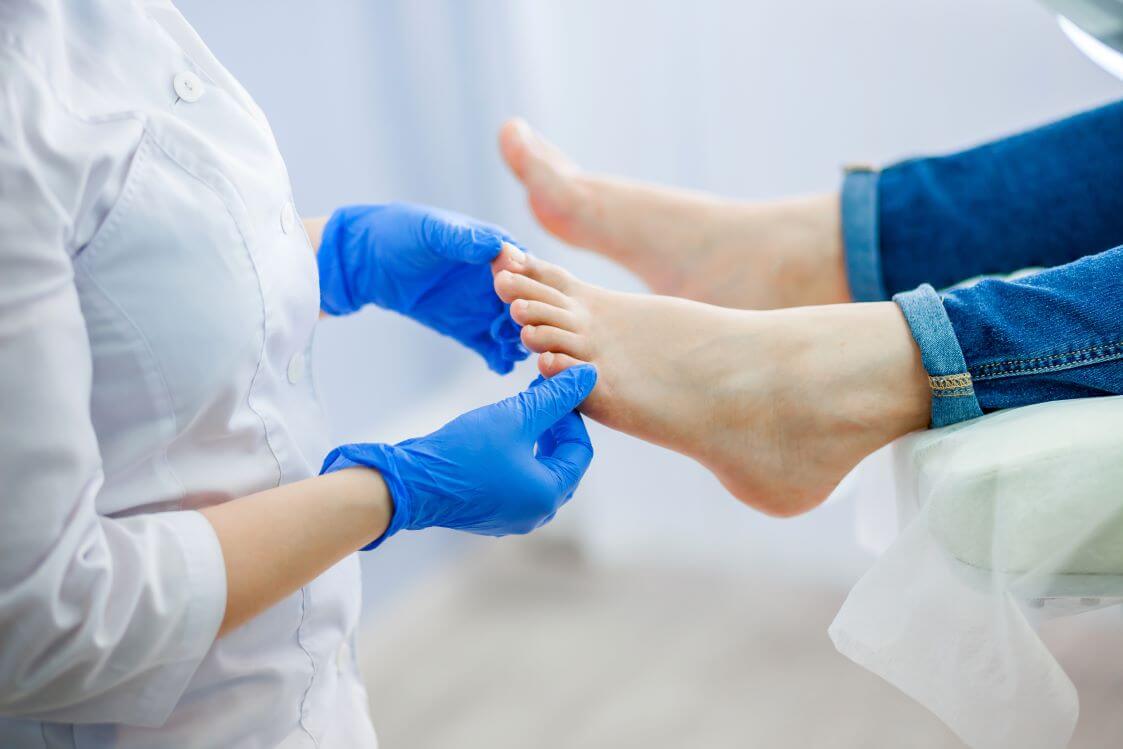A trip to the dermatologist isn’t necessarily the first thing people think of when they notice something odd going on with their toenails, but nail health is actually an important part of the dermatologic specialty. White toenails are among the most common nail conditions treated by dermatologists. According to Dr. John “Jay” Wofford of U.S. Dermatology Partners in Dallas and Plano, Texas, “White toenails, referred to as leukonychia by medical professionals, are relatively common in male patients, with incidence increasing significantly as men age.” While men are more prone to this condition, it can certainly impact women as well. It’s typically a benign condition, but there are some situations where white toenails indicate something more serious. In this blog, Dr. Wofford will discuss the common causes of white toenails and recommended treatment options.
Causes of White Toenails
According to Dr. Wofford, “There are many causes of white toenails, but the two most common, representing over 90% of all cases that I see in my clinic, are trauma and nail fungus (onychomycosis). Those who have common dermatologic conditions, such as psoriasis and atopic dermatitis (eczema), may also develop white nails. Rarely, more serious underlying health conditions, including liver disease, kidney disease, hyperthyroidism, protein deficiency, and vitamin or mineral deficiencies, lead to leukonychia. Finally, some medications, especially systemic chemotherapy, cause white nails.”
Signs and Symptoms
The most common and apparent symptom is whitening of the nails, but the amount of toenail discoloration and the way the nails are discolored may help determine the underlying cause. For this reason, your dermatologist may diagnose or reference a specific type of leukonychia, including:
- True leukonychia – This is the most common type. It’s caused by damage, and it may lead to the whitening of part or all of the nail.
- Punctate leukonychia – Also caused by damage to the nail, this form of leukonychia is usually attributed to nail biting, frequent manicures and pedicures, and tight footwear. It causes white spots on toenails.
- Striate leukonychia – Creates vertical or horizontal lines across the nail. It may also cause ridges to appear in nails. This is most often linked to a damaged nail matrix, that white half-circle at the bottom of the nail.
- Total leukonychia – The full nail turns white, and it often detaches from the nail bed. This is a common occurrence in foot injuries or for runners, especially when wearing ill-fitting shoes.
- Psuedoleukonychia – White spots are caused by fungus or other external factors. Once these conditions are treated, white spots typically clear up.
- Apparent leukonychia – If the nail whiteness disappears when pressure is applied to the nail bed, it may be apparent leukonychia, which is a form of nail whiteness that occurs due to a disease of the nail bed. The spots themselves are on the nail bed not the nail.
Treatment Options
As outlined by Dr. Wofford, “Treatment for white nails will depend on the cause. If fungus is suspected, a nail clipping may be taken and sent for evaluation. Often, antifungal treatment is offered simply based on the classic appearance of nail fungus, with no testing required.”
Laser treatment can be used to destroy fungi growing on nails, speeding up the typical results of treatment for this condition. According to Dr. Wofford, “Any treatment or intervention will take six to nine months to yield results due to the slow nature of toenail growth.” For this reason, laser treatment may be recommended to more quickly destroy toenail fungus, improving the health of the nail and accelerating regrowth. Laser treatment is often recommended in conjunction with oral and/or topical antifungal medications.
For nails that are damaged, simply waiting for them to grow out may be the best option. According to Dr. Wofford, “For trauma-related leukonychia, simple avoidance or mitigation of the trauma can resolve the issue. I recommend paying close attention to the fit of athletic shoes, advising my patients to make sure that the toe of the shoe is not too tight laterally or that the length of the shoe is not too short. I also recommend regular moisturization of the skin around the nail, including the cuticle, with moisturizing cream as an OTC means to improve nail appearance.”
For those who prefer at-home care, Dr. Wofford recommends, “For trauma-related nail discoloration, the OTC product I often recommend is Tolvere. For nail fungus, the most effective treatment option is prescription medication. However, there is one OTC product, Tolcylen, that I frequently recommend to patients for treating nail fungus.”
Prevention Tips
Preventing white toenails is often about mitigating potential causes. Dr. Wofford says, “White toenails resulting from trauma, especially in long-distance runners or those participating in high-intensity training, may not be preventable. Wearing well-fitting (but not too tight) footwear can help. Additionally, moisturizing the skin around the nail on a regular basis goes a long way toward improving nail appearance. I also recommend avoiding nail polish and nail polish remover, as these chemicals are harsh to the nail plate and can actually contribute to leukonychia in the long term.”
When to Seek a Dermatologic Evaluation
When it comes to seeking a dermatologic evaluation, Dr. Wofford says, “In some cases, white toenails may be indicative of an underlying health issue. However, there are signs that one can look for that indicate an underlying condition may be the cause of leukonychia. Most notably, white discoloration of the nails in a symmetric or patterned distribution that affects fingernails and toenails likely indicates a systemic cause for leukonychia and should prompt a medical evaluation. Additionally, a white appearance of the nail that disappears when the nail is pressed downward against the nail bed (apparent leukonychia) usually indicates an underlying health condition. Again, this finding will be seen symmetrically involving most or all nails. I recommend someone see their dermatologist if they have white nails involving all or most of the nails on their toes and fingers or white discoloration that has a symmetric pattern involving most or all nails.”
Keep Your Toenails & Whole Body Healthy
With spring and summer right around the corner, it may be time to start thinking about improving the health and appearance of your nails. A dermatologist can help you evaluate the causes of white toenails and find the perfect treatment option. For most people, white nails are not an indication that there is something serious wrong, but it’s always best to know for sure.
Schedule a Dermatologic Consultation
Whether you want to improve the appearance of your nails or you’re concerned white toenails may be an indication of a more serious condition, the knowledgeable dermatologists at U.S. Dermatology Partners are here to help. Looking for a dermatologist near your home or office? Just take a few moments to fill out our online request form to get started working with us.
Find a location near me
or


